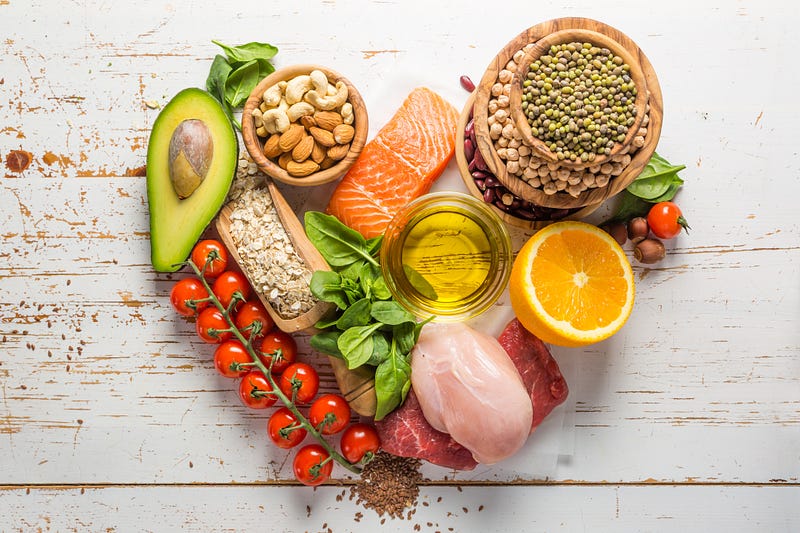
Managing your own weight loss journey is a process that is unique for everyone. With all the tips, tricks and various sources of information that are out there, it can be confusing to figure out what you should incorporate into your lifestyle and what isn’t quite right.
Piecing all the information together can be a bit of a puzzle — what to eat, when to eat, how much to eat… At the end of the day, weight maintenance and weight loss is all about balancing energy in (food and drink) with energy out (exercise, basal rate and digestion).
Counting calories is a common approach to getting this balance right, however counting calories daily isn’t for everyone. An alternative approach is getting familiar with each of the food groups and the servings sizes within these, to create well balanced meals. Throughout the week, our Fresh Start recipes cover all of these food groups, and at a minimum, each dish will always provide a combination of lean protein, vegetables and unprocessed carbohydrates.
We have provided a breakdown of each of the food groups below and some examples of servings sizes:
Fruit (2 serves per day)
Fruits contain vitamins, minerals, fibre and are a natural source of sugar. One serving fits into the palm of your hand:
· 1 apple
· ½ banana
· 2 small mandarins
Vegetables (3+ serves per day)
Vegetables contain vitamins, minerals, fibre and are usually lower in natural sugars than fruit. Different coloured veggies will provide different nutrient profiles, so aim to eat a variety of colours! Most vegetable servings fit into the palm of your hand. However, a serve of leafy veggies (such as spinach and lettuce) will fit into two hands cupped together:
· 1 cup of spinach
· ½ cup of broccoli, pumpkin or sweetcorn
· ½ cup of mixed frozen vegetables
Lean protein (2 serves per day)
During digestion, protein rich foods such as meat and legumes, are broken down into building blocks called amino acids, these are used throughout the body to repair muscles, help with muscle growth, build hormones and other signaling molecules. One serving of red meat or chicken will be the width and size of the palm of your hand, whereas one serving of white fish will be the length and width of your hand:
· 1 medium fillet of cooked fish
· 2 medium eggs
· 100g of lean red meat
· ¾ cup of legumes (e.g. beans, lentils, chickpeas)
Dairy or substitutes (2 serves per day)
Dairy food includes milk products and milk alternatives, such as fortified soy milk — this means it has nutrients such as calcium and vitamin B12 added to it. Dairy foods contain protein, vitamins and minerals such as calcium and vitamin D. Serving sizes vary depending on the type of dairy food:
· 1 cup of low fat milk or fortified milk alternative
· 2 slices/2 Tbs of low fat cheese (e.g. feta, ricotta, cottage cheese Edam)
· 1 pottle of low fat, unsweetened yoghurt
Healthy fats (2 serves per day)
Healthy fats are found in plant sources such as in nuts, seeds, avocados, and plant oils (except for coconut and palm oil). Healthy fats are mono- and poly-unsaturated fats, which are far better for your heart than the saturated fats you’ll find in butter, meat fat and fried food. Try sticking to a couple of tablespoons of healthy fats per day because they are still high in calories! One serving is roughly the size of the tip of your thumb (one Tablespoon):
· One handful of nuts or seeds (30g)
· 1 teaspoon of olive oil
· 1 Tablespoon of unsalted and unsweetened peanut butter
Unprocessed carbohydrates (3 serves per day)
Unprocessed carbohydrates contain the ‘germ’ and the ‘bran’, whereas refined carbohydrates (such as white bread and white rice) are missing these two nutrient-packed components. The germ and the bran provide fibre, B vitamins, healthy fats, vitamin E, magnesium and some protein. One serving is the size of your clenched fist:
· 1 slice of wholegrain bread (aim for >6g fibre per 100g)
· ½ cup of cooked brown rice or quinoa
· ½ cup of cooked oats
Click here to return to Fresh Start.

